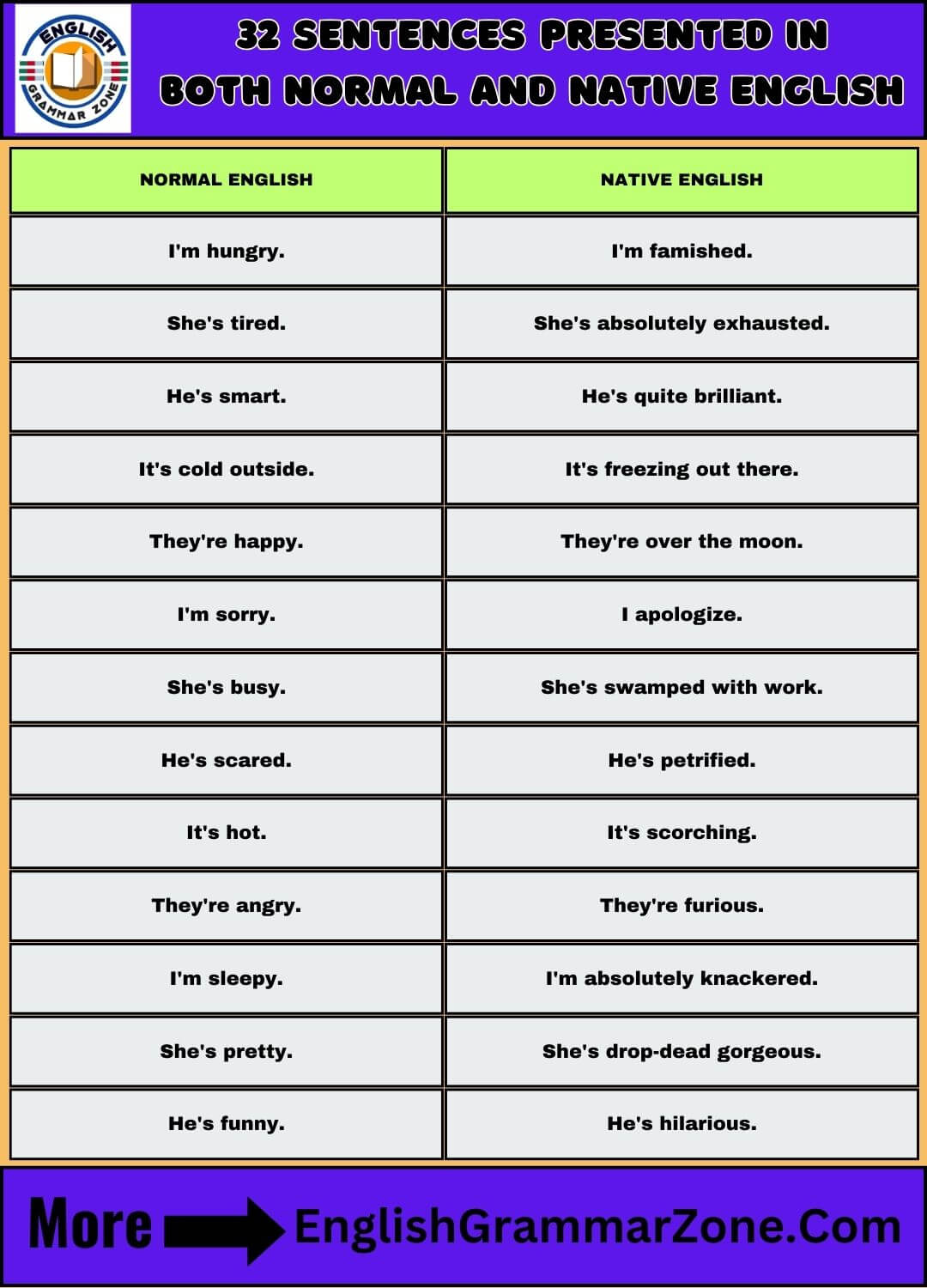In today’s global communication landscape, it’s crucial to use normal and native English. This means employing the language in a way that is natural, colloquial, and reflective of how it is spoken by fluent English speakers.
Using normal and native English has several benefits:
- It improves clarity and comprehension, as the language aligns with the audience’s expectations and familiarity.
- It establishes credibility and professionalism, as it demonstrates a strong command of the language.
- It creates a more engaging and relatable tone, fostering better connections with readers or listeners.
Whether you’re writing content for a website, crafting a business proposal, or preparing a speech, prioritizing normal and native English can make a significant difference in the effectiveness of your communication.
Details of 32 sentences presented in both normal and native English
| Normal English | Native English |
| I’m hungry. | I’m famished. |
| She’s tired. | She’s absolutely exhausted. |
| He’s smart. | He’s quite brilliant. |
| It’s cold outside. | It’s freezing out there. |
| They’re happy. | They’re over the moon. |
| I’m sorry. | I apologize. |
| She’s busy. | She’s swamped with work. |
| He’s scared. | He’s petrified. |
| It’s hot. | It’s scorching. |
| They’re angry. | They’re furious. |
| I’m sleepy. | I’m absolutely knackered. |
| She’s pretty. | She’s drop-dead gorgeous. |
| He’s funny. | He’s hilarious. |
| It’s dark. | It’s pitch black. |
| They’re sad. | They’re heartbroken. |
| I’m happy. | I’m on cloud nine. |
| She’s nice. | She’s incredibly kind-hearted. |
| He’s strong. | He’s as strong as an ox. |
| It’s warm. | It’s sweltering. |
| They’re worried. | They’re fretting over it. |
| I’m busy. | I’m up to my neck in work. |
| She’s afraid. | She’s shaking in her boots. |
| He’s lazy. | He’s bone idle. |
| It’s cool. | It’s chilly. |
| They’re confused. | They’re all at sea about it. |
| I’m excited. | I’m bouncing off the walls. |
| She’s pretty. | She’s drop-dead gorgeous. |
| He’s hilarious. | He cracks me up. |
| It’s scary. | It’s hair-raising. |
| They’re mad. | They’re off their rocker. |
| I’m tired. | I’m absolutely knackered. |
| She’s smart. | She’s sharp as a tack. |
| He’s happy. | He’s walking on air. |
These pairs showcase how everyday phrases can be transformed into more expressive and idiomatic expressions used by native English speakers.
Read Also 72 Basic and Advanced Vocabulary List


Tips for Using Normal and Native English
1. Avoid overly formal or complicated language
Normal and native English is characterized by a more conversational tone. Steer clear of excessively formal or complex vocabulary and sentence structures, which can make your writing or speech appear stilted or inaccessible.
2. Use common idioms and colloquialisms
Incorporate idiomatic expressions and colloquial phrases that are commonly used by native English speakers. This helps your language sound more natural and relatable.
3. Adapt to your audience
Consider the background and familiarity of your audience with the English language. Adjust your level of formality and complexity accordingly to ensure your message is clearly understood.
4. Prioritize clarity over complexity
When given the choice between a more complex or a simpler way of expressing an idea, opt for the simpler, more straightforward approach. This helps maintain a natural, easy-to-follow flow.
5. Read aloud and listen to native speakers
Practice reading your writing aloud and pay attention to how native English speakers communicate. This can help you identify areas for improvement and refine your use of normal and native English.
By implementing these tips and continuously striving to use normal and native English, you can enhance the clarity, credibility, and overall effectiveness of your written and verbal communication.
Conclusion
In conclusion, the use of normal and native English is a crucial aspect of effective communication in today’s world. By embracing this approach, you can enhance clarity, credibility, and engagement, ultimately leading to better outcomes in your personal and professional endeavors.

